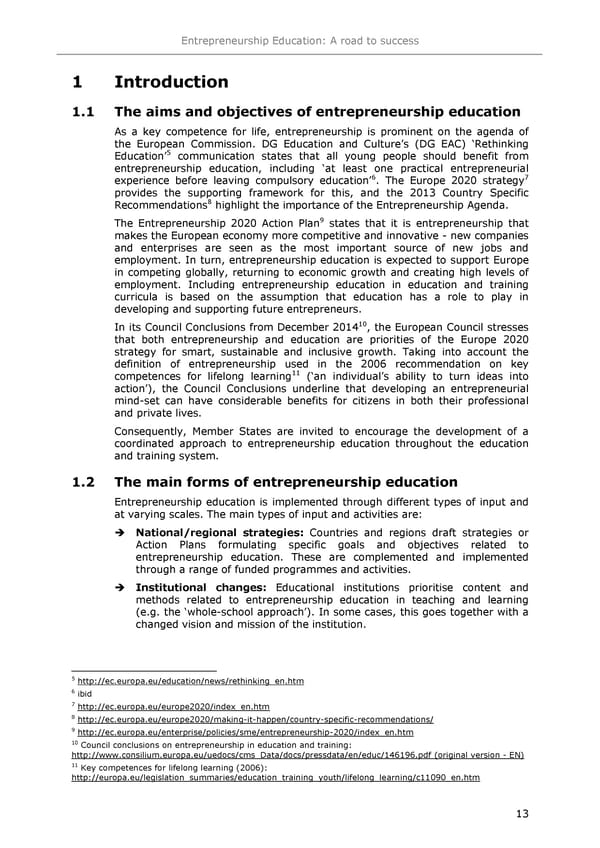Entrepreneurship Education: A road to success 1 Introduction 1.1 The aims and objectives of entrepreneurship education As a key competence for life, entrepreneurship is prominent on the agenda of the European Commission. DG Education and Culture9s (DG EAC) 8Rethinking 5 Education9 communication states that all young people should benefit from entrepreneurship education, including 8at least one practical entrepreneurial 6 7 experience before leaving compulsory education9 . The Europe 2020 strategy provides the supporting framework for this, and the 2013 Country Specific Recommendations8 highlight the importance of the Entrepreneurship Agenda. The Entrepreneurship 2020 Action Plan9 states that it is entrepreneurship that makes the European economy more competitive and innovative - new companies and enterprises are seen as the most important source of new jobs and employment. In turn, entrepreneurship education is expected to support Europe in competing globally, returning to economic growth and creating high levels of employment. Including entrepreneurship education in education and training curricula is based on the assumption that education has a role to play in developing and supporting future entrepreneurs. In its Council Conclusions from December 201410, the European Council stresses that both entrepreneurship and education are priorities of the Europe 2020 strategy for smart, sustainable and inclusive growth. Taking into account the definition of entrepreneurship used in the 2006 recommendation on key competences for lifelong learning11 (8an individual9s ability to turn ideas into action9), the Council Conclusions underline that developing an entrepreneurial mind-set can have considerable benefits for citizens in both their professional and private lives. Consequently, Member States are invited to encourage the development of a coordinated approach to entrepreneurship education throughout the education and training system. 1.2 The main forms of entrepreneurship education Entrepreneurship education is implemented through different types of input and at varying scales. The main types of input and activities are: National/regional strategies: Countries and regions draft strategies or Action Plans formulating specific goals and objectives related to entrepreneurship education. These are complemented and implemented through a range of funded programmes and activities. Institutional changes: Educational institutions prioritise content and methods related to entrepreneurship education in teaching and learning (e.g. the 8whole-school approach9). In some cases, this goes together with a changed vision and mission of the institution. 5 http://ec.europa.eu/education/news/rethinking_en.htm 6 ibid 7 http://ec.europa.eu/europe2020/index_en.htm 8 http://ec.europa.eu/europe2020/making-it-happen/country-specific-recommendations/ 9 http://ec.europa.eu/enterprise/policies/sme/entrepreneurship-2020/index_en.htm 10 Council conclusions on entrepreneurship in education and training: http://www.consilium.europa.eu/uedocs/cms_Data/docs/pressdata/en/educ/146196.pdf (original version - EN) 11 Key competences for lifelong learning (2006): http://europa.eu/legislation_summaries/education_training_youth/lifelong_learning/c11090_en.htm 13
 Entrepreneurship Education Page 16 Page 18
Entrepreneurship Education Page 16 Page 18